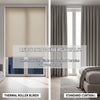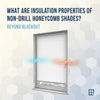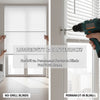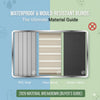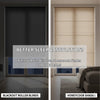Blinds vs. Curtains: Which Window Treatment Saves More Energy?
- by Mariam Labadze
Quick Answer
Blinds generally provide superior energy efficiency compared to curtains through engineered insulation—cellular honeycomb blinds achieve R-values up to 5.0, whilst even heavy curtains rarely exceed R-3.0. However, the most effective approach combines both: thermal blinds providing baseline insulation with curtains adding supplementary layers during temperature extremes. Cellular blinds excel through trapped air pockets specifically designed for thermal performance, thermal-backed rollers reflect solar heat before entering rooms, and wooden venetians provide natural insulation. Curtains contribute through heavyweight fabrics creating dead air spaces, though their loose fit allows air circulation that compromises effectiveness. Strategic usage matters tremendously—closing treatments at dusk during winter retains heat, whilst daytime closure in summer blocks solar gain. Combined systems can reduce heating and cooling costs by 25-35% versus single treatments' 15-20% savings.
Understanding Heat Transfer Through Windows
Why Windows Lose Energy – Windows represent homes' thermal weak points, accounting for 25-30% of heating and cooling costs despite comprising only 10-15% of exterior surfaces. Even quality double-glazing provides minimal thermal resistance (R-2 to R-3) compared to insulated walls (R-11 to R-19), making window treatment contributions to overall thermal performance disproportionately valuable.
Heat transfers through three mechanisms: conduction through glass and frames, convection from air movement near cold surfaces, and radiation from infrared energy passing through glass. Effective window treatments address all three simultaneously, creating measurable improvements in home comfort whilst reducing energy bills.
The Air Gap Principle – Stationary air acts as excellent insulation because it prevents convective heat transfer. Window treatments create dead air spaces between glass and room interiors, trapping air and slowing heat movement. This fundamental principle explains why both blinds and curtains provide insulation, though effectiveness varies based on how completely they trap air without allowing circulation undermining insulating benefits.
Cellular Blinds: Purpose-Built Efficiency
Engineered Insulation – Cellular or honeycomb blinds represent the gold standard for window insulation through structures specifically designed for thermal performance rather than treating energy efficiency as incidental benefit. The distinctive hexagonal cells trap air in multiple pockets, creating insulating barriers that significantly enhance window thermal resistance.
Single-cell designs achieve R-values around 2.0-3.0, whilst double-cell constructions reach 4.0-5.0—adding substantial insulation to windows' baseline performance. This engineered approach delivers results that general-purpose products cannot match through their broader design priorities.
Year-Round Performance – Cellular blinds work bidirectionally—reducing heat loss during winter whilst blocking solar heat gain in summer. This dual functionality provides energy savings throughout the year rather than seasonal benefits that heating-only or cooling-only solutions offer.
Light-filtering cellular options provide insulation whilst admitting natural daylight, reducing artificial lighting needs that contribute to cooling loads. Blackout versions maximize thermal performance alongside bedroom darkness, addressing multiple requirements through single solutions.
Quantifiable Savings – Studies demonstrate cellular blinds reducing window heat loss by 40-50% and solar heat gain by similar percentages. On homes spending £1,800 annually on heating and cooling, comprehensive cellular blind installation might save £270-£450—substantial returns justifying premium pricing through measurable utility bill reductions.
Thermal-Backed Roller Blinds: Practical Efficiency
Reflective Technology – Thermal roller blinds feature specialized backing materials—foam, aluminum, or synthetic layers—bonded to decorative fabrics. These backings reflect radiant heat whilst creating modest insulating air gaps between fabric and glass, providing meaningful thermal improvements without cellular blinds' premium costs.
The slim profile suits any window whilst delivering R-values around 1.0-2.0—not matching cellular performance but significantly better than standard fabric alone. This practical middle ground appeals to budget-conscious households seeking energy benefits without maximum possible investment.
Solar Heat Rejection – Reflective thermal blinds excel at rejecting summer solar heat before it enters homes. Light-colored or metallic-backed fabrics bounce sunlight preventing heat buildup that forces cooling systems working harder. South and west-facing rooms particularly benefit from this passive cooling that reduces afternoon air conditioning demands substantially.
Cost-Effectiveness – Thermal rollers typically cost 30-40% less than equivalent cellular blinds whilst delivering 60-70% of the thermal performance. This value proposition makes them attractive for whole-house applications where budget constraints prevent comprehensive cellular installation despite recognizing superior performance.
Wooden Venetian Blinds: Natural Insulation
Material Properties – Wood's cellular structure inherently resists heat transfer better than aluminum or vinyl alternatives. Real wood slats create modest insulation even when open, with thermal advantages increasing substantially when slats close tightly forming near-continuous wood barriers between glass and room interiors.
The 25-50mm slat thickness provides more insulating mass than thin materials, slowing temperature transfer through conduction. Combined with air gaps between closed slats adding convective resistance, wooden venetians deliver combined thermal benefits that appearance-driven selection doesn't typically consider.
Adjustable Optimization – Slat angle adjustment allows optimizing passive solar heating during winter—positioning slats admitting low-angle winter sunlight whilst maintaining privacy. This control proves impossible with fixed treatments, giving venetians unique flexibility for seasonal energy optimization that static solutions cannot provide.
Summer strategies involve closing slats against intense sun whilst maintaining ventilation through gaps—balanced approaches reducing cooling loads without creating stuffiness that completely closed treatments might cause.
Curtains: Traditional Approach
Fabric Insulation – Heavy curtains create insulation through substantial fabric mass and the air gap between curtains and glass when properly hung. Thermal-lined curtains feature additional insulating layers bonded to decorative fabrics, improving performance beyond single-layer alternatives.
However, curtains' loose fit allows air circulation at tops, bottoms, and sides that reduces effectiveness compared to sealed blind systems. This edge leakage permits convection currents undermining insulation that material thickness alone might suggest.
Thermal Lining Variations – Basic linings provide modest improvement, thermal interlinings add specialized insulating layers, and blackout linings combine light blocking with enhanced thermal performance. These lining options allow tailoring curtain performance to specific requirements and budgets.
Practical Limitations – Curtains' bulky stacked appearance when open consumes significant wall space that compact blind systems avoid. This space consumption proves problematic in compact rooms where every centimeter matters for furniture placement and visual spaciousness.
The operational inconvenience of fully opening and closing curtains daily means many households leave them partially drawn continuously, compromising both natural light access and thermal performance that proper usage would deliver.
Direct Performance Comparison
Insulation Values – Cellular blinds achieve highest R-values (2.0-5.0), thermal rollers provide moderate performance (1.0-2.0), wooden venetians offer modest improvement (0.5-1.5), and heavy lined curtains reach 2.0-3.0 maximum. These quantified differences reveal cellular blinds' engineered advantage over alternatives relying on material mass rather than sophisticated structural design.
Edge Sealing – Blinds mounted with side channels eliminate air gaps entirely, whilst recess-mounted blinds minimize edge leakage. Curtains inherently allow substantial edge circulation unless elaborate sealed track systems address this limitation—solutions few residential installations implement.
This sealing difference significantly affects real-world performance despite theoretical material R-values suggesting closer competition. Poorly sealed treatments lose effectiveness through convection that material properties alone cannot prevent.
Operational Compliance – Energy savings require consistent proper usage—closing treatments during temperature extremes, opening them when beneficial. Blinds' operational ease encourages compliance, whilst curtains' inconvenience often results in suboptimal positioning that reduces actual savings below potential maximum performance.
The Combined Approach: Maximum Efficiency
Layered Systems – The most effective strategy combines cellular or thermal blinds providing baseline insulation with curtains adding supplementary layers during extreme conditions. This pairing delivers 25-35% energy savings versus single treatments' 15-20% reductions, justifying the additional investment and installation complexity through superior performance.
Use blinds as primary treatments operating daily for basic insulation and light control. Deploy curtains during coldest winter nights or hottest summer afternoons when additional insulation proves most valuable, creating flexible systems adapting to varying seasonal demands.
Strategic Deployment – Not every window requires combined treatments. Prioritize layering on largest windows, those facing temperature extremes (north in winter, south/west in summer), and rooms where comfort matters most. Single treatments prove adequate for smaller windows or moderate-exposure orientations.
This targeted approach optimizes investment, directing premium solutions toward highest-impact applications whilst accepting adequate performance elsewhere, balancing comprehensive energy efficiency with realistic budgets.
Practical Usage Strategies
Winter Optimization – Close all treatments at dusk before temperatures drop, trapping interior warmth accumulated during the day. Open south-facing treatments during sunny days allowing passive solar heating, then close before sunset preventing accumulated heat escaping overnight.
This active management maximizes energy savings that passive approaches cannot achieve. The difference between merely owning thermal treatments and using them strategically often equals or exceeds performance differences between treatment types.
Summer Cooling – Close treatments on south and west-facing windows during intense afternoon sun, preventing solar heat gain that increases cooling loads dramatically. East-facing windows benefit from morning closure preventing early heat buildup that creates uncomfortable conditions lasting throughout days.
Evening opening after outdoor temperatures drop allows natural ventilation and cooling, reducing overnight air conditioning needs whilst maintaining daytime protection from solar radiation.
Automation Benefits – Motorized treatments with scheduling eliminate the manual effort that causes inconsistent usage undermining potential savings. Program optimal opening and closing times for each window based on orientation and seasonal sun paths, ensuring consistent energy-saving behavior without daily attention or discipline.
This automation often delivers better results than manual operation of theoretically superior treatments that human inconsistency undermines through forgotten adjustments or delayed responses to changing conditions.
Cost-Benefit Analysis
Initial Investment – Cellular blinds cost £60-£150 per window, thermal rollers £40-£100, wooden venetians £80-£200, and quality thermal curtains £100-£250 per window. These substantial investments require justification through energy savings, improved comfort, and extended lifespans that cheap alternatives cannot deliver.
Payback Periods – On homes spending £1,800 annually on heating and cooling, comprehensive cellular blind installation costing £1,500 might save £270-£450 yearly, creating payback periods of 3-6 years. This timeframe compares favorably to other energy improvements whilst delivering immediate comfort benefits that pure financial calculations don't capture.
Long-Term Value – Quality treatments lasting 10-15 years provide energy savings throughout entire lifespans. A £1,200 cellular blind investment saving £300 annually over 12 years returns £3,600 in utility savings—triple the initial investment whilst improving daily comfort and supporting environmental responsibility.
At 1 Click Blinds, we help UK homeowners selecting energy-efficient solutions matching their specific needs, climates, and budgets. Whether prioritizing maximum thermal performance through cellular designs, practical efficiency via thermal rollers, or combined systems delivering ultimate savings, our range includes appropriate options backed by expertise ensuring your window treatment investments deliver measurable comfort and cost benefits for years ahead.

